The good cheer and euphoria prompted by the unprecedented number of high performers in the class X/XII board exams, has dissipated with dawning awareness that grades inflation has been ubiquitous this year. Conterminously sky-high cut-offs stipulated by the best colleges have made the admission process a nightmare. Summiya Yasmeen reports
 On June 1, daily newspapers splashed the joyful faces of cheerful 15-17-year-olds across the country who topped the school-leaving exams of the Delhi-based Central Board of Secondary Education (CBSE) — the country’s largest pan-India examinations board.
On June 1, daily newspapers splashed the joyful faces of cheerful 15-17-year-olds across the country who topped the school-leaving exams of the Delhi-based Central Board of Secondary Education (CBSE) — the country’s largest pan-India examinations board.
For the first time in the 59-year history of CBSE, the national pass percentage rose to 98.6 percent (cf. 91.1 percent in 2010) with the number of students who averaged 90 percent plus recording an all-time high. Of the 1 million students countrywide who wrote the class X exam conducted by the board or school (for the first time students had the option of writing a school-conducted class X exam) in March, and were assessed as per the board’s new continuous and compre-hensive evaluation (CCE) system, 3.8 percent (38,377) scored a perfect cumulative grade point average (CGPA) of 10 (91-100 percent). This was a great improvement over 2010 when a mere 1.2 percent (11,005) of the 902,517 students who wrote the class X exam scored 90 percent plus.
New records were also set in CBSE’s more difficult class XII school-leaving examination. A new high of 81.71 pass percentage was recorded — a modest 1.84 percent improvement over last year. But the number of high performers in the 90 percent-plus category swelled by 30 percent to 21,665 from 16,563 last year. The number of students scoring 95 percent and above also reached a new high — almost doubling to 2,097 from 1,202 in 2010. Little wonder, good cheer and euphoria all around.
However since then, much of the euphoria has dissipated as awareness has dawned upon students and principals that the spectacular board exam results were not peculiar to their school, but the experience of almost all 10,000-plus CBSE-affiliated secondaries and higher secondaries countrywide. With sky-high college admission cut-offs prescribed for class XII students (Delhi University’s 77 affiliated colleges have hiked admission cut-offs by 12-14 percent to 90-100 percent), questions are being raised about CBSE’s inflationary grading which has admitted an unprecedented number of 21,665 students in the elite 90 percent club.
Within staff rooms of the country’s top K-12 schools and academic community, the emerging consensus is that marking and evaluation under CBSE’s new CCE system, which accords substantial weightage to in-house assessment done by schools, was too generous.
.gif) But Vineet Joshi, chairman of CBSE, (who failed to respond to numerous phone calls from EducationWorld) refutes this charge. “There was a lot of speculation about board exams being made optional and schools being given more weightage. But it gave us the best result. Whether a student was assessed by a school or the board, everything was monitored. So it is not generosity, but success of reforms,” (sic) Joshi told reporters in Delhi (The Tribune, June 1).
But Vineet Joshi, chairman of CBSE, (who failed to respond to numerous phone calls from EducationWorld) refutes this charge. “There was a lot of speculation about board exams being made optional and schools being given more weightage. But it gave us the best result. Whether a student was assessed by a school or the board, everything was monitored. So it is not generosity, but success of reforms,” (sic) Joshi told reporters in Delhi (The Tribune, June 1).
The reforms to which Joshi attributes the spectacular performance of CBSE students are the slew of initiatives announced by Kapil Sibal, Congress party heavyweight, top Supreme Court counsel and Union human resource development (HRD) minister, to reduce student stress and board examinations anxiety. These liberal initiatives limited to the CBSE — a Central government-promoted school-leaving and other examinations board under direct control of the HRD ministry — have decreed the class X board exam optional; intro-duced the CCE system and have mandated assessments of students’ soft skills and co-curricular activities in the final report card.
CCE — the centrepiece of CBSE’s new exam reforms — was introduced last year to replace the sudden death examination which assessed students’ capabilities in a final exam. Under this new evaluation system, a class X student’s performance is continuously appraised through formative assessment (FA, 40 percent) and summative assessment (SA, 60 percent). FA is done by teachers and covers non-scholastic skills such as creative and critical thinking, decision-making and other life skills, with weightage given to extra-curricular activities.
On the other hand, SA is conducted on the basis of students’ performance in the written first term and final exams with weightages of 20 and 40 percent. However the first term exam is conducted by schools themselves with students given the option to choose between writing the final exam conducted by the CBSE board or the school (students who want transfer to the state board or equivalent in class XI have to compulsorily write the exam conducted by CBSE). Given the option to write the internally or externally conducted exam, 67 percent of the 1 million class X CBSE students opted to write the final exam conducted by their schools.
Under the complex but unprecedentedly liberal new CBSE class X assessment system, affiliated schools are obliged to send students’ FA and SA (performance in first term and final exam in case the student has opted to write the school exam) scores to the board by April, after which its examiners collate the final cumulative grade point average (formative plus summative assessment) of each student. But irrespective of whether students have written the final summative exam conducted by the school or board, all students are awarded a common CBSE-certified report card running into six pages, detailing performance in a range of non-scholastic areas and academics. The report card studiously avoids disclosing whether the student has written the school or board-conducted final exam.
Comments Praveen Vasisht, principal of the top-rated CBSE-affiliated Lawrence School, Sanawar: “The increase in the pass percentage and number of top scorers this year is because of the introduction of the CCE system. Under CCE, students are evaluated through the year and tested on shorter course portions with school teachers doing most of the assessment. Only 30 percent of assessment is done externally by the board.”
Although officially CBSE board members decline to admit it, privately they concede that the 360 degree turn in evaluation methodology with affiliated schools given the full freedom and authority to assess student perform-ance, is the main reason for the quantum jump in the number of 90 percenters. “Until this year, schools didn’t play any role in student evaluation. But this year, over 60 percent of the evaluation has been done by schools. Moreover students who declined to write the external exam conducted by the board, were evaluated entirely by their schools. Even those who wrote the board exam were subject to 60 percent assessment by their schools whose teachers have been too generous in their marking,” says a CBSE spokesperson who preferred to remain anonymous.
 Now with the dust kicked up by the celebrations over unparalleled pass percentages and high performers having settled, it’s becoming increasingly apparent that, for reasons of institut-ional prestige and reputation, the managements and teachers of CBSE schools have assessed and evaluated their class X students too liberally. With parents and society in general placing great premium on class X board results as true indicators of a school’s acad-emic excellence — it’s become routine for schools to trumpet their board results to the media and public (over the past month EducationWorld has been flooded with letters/press releases from principals of some of the country’s top CBSE schools claiming exceptional class X/XII results and boasting a record number of first divisions) — it’s plain that teachers encouraged by school manage-ments, erred on the side of excessive generosity.
Now with the dust kicked up by the celebrations over unparalleled pass percentages and high performers having settled, it’s becoming increasingly apparent that, for reasons of institut-ional prestige and reputation, the managements and teachers of CBSE schools have assessed and evaluated their class X students too liberally. With parents and society in general placing great premium on class X board results as true indicators of a school’s acad-emic excellence — it’s become routine for schools to trumpet their board results to the media and public (over the past month EducationWorld has been flooded with letters/press releases from principals of some of the country’s top CBSE schools claiming exceptional class X/XII results and boasting a record number of first divisions) — it’s plain that teachers encouraged by school manage-ments, erred on the side of excessive generosity.
Comments Manjula Raman, principal of Bangalore’s CBSE-affiliated K-12 Army Public School which has an enrolment of 2,300 students: “Though all schools were given tight frameworks and random checks and monitoring were conducted by CBSE officials, schools had great freedom in assessing students’ academic and non-academic performance. Moreover this was the first time teachers were assessing students’ non-scholastic performance in a wide range of life skills which is given a substantive 40 percent weightage.”
Raman believes teachers of CBSE schools were insufficiently trained to implement this new system. “Not properly trained and fearful of being accused of indul-ging in favouritism or being too strict, the majority of teachers seem to have been very generous in their evaluation in the formative and summative assessment processes. But this is the first year of CCE implementation. Hopefully with greater teacher training, evaluation parameters will become tighter and there will be standardisation of assessment in all schools,” says Raman.
Following the outbreak of marks hyper inflation because of inadequate teacher training to effectively implement the new CCE system (which is in the public interest because for the first time some weightage is given to students’ non-scholastic capabilities, thereby promoting holistic education), there’s apprehension within the academic community that CCE may get derailed. Under the CCE system, teachers are required to fill up multiple forms, maintain performance records of every student and constantly design tests and assessment formats — all of which requires intensive training and development.
“CCE is an educational reform whose intent can’t be faulted. If understood and implemented effectively in spirit and practice, it could improve classroom pedagogies and students’ learning outcomes. Teachers are the primary agents of change in classrooms and need to be supported to implement the CCE initiative effectively. Yet do all schools make co-curricular activities available to students? If so, are teachers trained to assess them objectively? These questions need to be addressed and teacher training accorded top priority to enable effective implementation of CCE. Intangibles like stakeholders’ beliefs and thinking require a dramatic paradigm shift,” says Mallika Mani, director, Srikriti Teacher Education Centre, Chennai and a well-known education consultant.
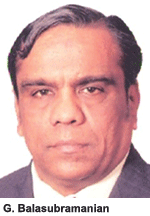 Even as factors such as inadequate teacher training, lax marking and dilution of evaluation parameters are being blamed for grades inflation in CBSE schools, there’s a small but growing minority of educationists who believe that children have become more knowledgeable and smarter in the new digital age, and hence the marked increase in the number of 90 percenters. “The dynamics of learning have changed over the past decade and competition has become intense. Conse-quently students have also become smarter given their access to a wide range of resources including supplem-entary content, digital technologies and the vast library that is the internet. Because of these factors students are averaging higher percentages. Today every child wants to be a topper and is working hard to achieve his/her goals,” says G. Balasubramanian, former director of academics, CBSE.
Even as factors such as inadequate teacher training, lax marking and dilution of evaluation parameters are being blamed for grades inflation in CBSE schools, there’s a small but growing minority of educationists who believe that children have become more knowledgeable and smarter in the new digital age, and hence the marked increase in the number of 90 percenters. “The dynamics of learning have changed over the past decade and competition has become intense. Conse-quently students have also become smarter given their access to a wide range of resources including supplem-entary content, digital technologies and the vast library that is the internet. Because of these factors students are averaging higher percentages. Today every child wants to be a topper and is working hard to achieve his/her goals,” says G. Balasubramanian, former director of academics, CBSE.
Certainly there’s no denying that today, the 13 million students enroled in India’s 12,000-plus high-end private schools affiliated with the pan-India CBSE and CISCE (Council for the Indian School Certificate Examinations) boards have access to a mind-boggling range of learning resources including digitised supplementary content, state-of-the-art labs and well-equipped libraries. Moreover it’s become de rigueur for students writing the class X/XII board exams to sign up with tutorial classes (aka coaching schools) whose special expertise is to tutor students in the art of topping exams.
While CBSE and the radical CCE are taking flak for grades inflation in its board exams, the rival CISCE, a fully autonomous Delhi-based body which has 1,800 of the coun-try’s top-ranked private schools including The Doon School, Dehradun; The Shri Ram School, Delhi; Cathedral & John Connon School, Mumbai among others affiliated with it, has been spared such criticism. Notwithstanding HRD minister Kapil Sibal unleash-ing a slew of exam reforms in CBSE over the past year, the low-profile CISCE has studiously desisted from changing its external evaluation system or experim-enting with in-house marking or grading.
Therefore the 122,347 class X students of CISCE-affiliated schools who wrote the board exam in March had their answer sheets externally evaluated as in previous years, with students awarded a maximum of 80 percent in the written exam and a maximum of 20 percent for research/project work. On May 17, CISCE announced a national pass percentage of 98.61 percent in the class X exam (up by 0.30 percent over 2010) and 97.24 percent in class XII (up by 0.13 percent). Despite several requests, the CISCE top management refused to disclose the percentage of students who averaged above 90 percent, or grant EducationWorld an interview.
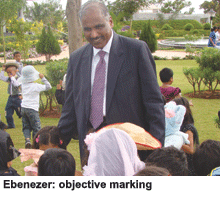 “Undoubtedly standards of evalu-ation and marking in CISCE are more rigorous than in CBSE. The board has laid down strict guidelines and all class X/XII evaluation is done by competent external examiners and is tightly monitored. There’s objectivity and standardisation in marking when exam papers are assessed externally rather than internally by school teachers. Moreover CISCE has introduced flexi-bility in terms of choice of subjects offered in secondary school. Class X students have the option to choose from a range of application-based subjects such as cookery, yoga, physical education, and art,” says Dr. Abraham Ebenezer, promoter-director of the CISCE and CIE (UK)-affiliated Ebenezer International School, Bangalore (estb. 2007) which has an enrolment of 956 students and 129 teachers.
“Undoubtedly standards of evalu-ation and marking in CISCE are more rigorous than in CBSE. The board has laid down strict guidelines and all class X/XII evaluation is done by competent external examiners and is tightly monitored. There’s objectivity and standardisation in marking when exam papers are assessed externally rather than internally by school teachers. Moreover CISCE has introduced flexi-bility in terms of choice of subjects offered in secondary school. Class X students have the option to choose from a range of application-based subjects such as cookery, yoga, physical education, and art,” says Dr. Abraham Ebenezer, promoter-director of the CISCE and CIE (UK)-affiliated Ebenezer International School, Bangalore (estb. 2007) which has an enrolment of 956 students and 129 teachers.
The pan-India CBSE and CISCE boards apart, the country hosts 40 state examination boards which also conduct class X school-leaving exams within their own jurisdictions. It’s an open secret that curriculums of state boards are less demanding than of the two national boards, and evaluation is less rigorous with a greater number of students averaging 90 percent plus. For instance in the class XII results announced last month, Maharashtra state board awarded 43,000 students over 90 percent, while Tamil Nadu’s 90 perc-enters aggregated 20,339 against last year’s 17,081. In fact, off the record most CBSE school principals admit the board loosened its evaluation parameters to enable students of CBSE schools to record higher percentages and place them on equal footing with state board students for college admission.
The fallout of grades inflation within school-leaving examination boards is that the country’s 31,000 undergraduate colleges — which are obliged to give equal weightage to the certification of all examination boards countrywide — are specifying incrementally higher percentages as admission cut-offs. For instance in early June, Delhi University (DU) announced cut-offs which are 12-14 percent higher than last year. The average admission cut-off stipulated by its 77 affiliated colleges ranges between 80-100 percent with the highly-reputed Shri Ram College of Commerce (SRCC) stipulating an unrealistic 100 percent for science students to qualify for admi-ssion into its commerce undergraduate programme. Despite specifying 95 percent and above cut-offs, the majority of DU colleges including SRCC have filled up their seats in the first cut-off list.
The absurdly high admission cut-off percentages demanded by DU prompted HRD minister Kapil Sibal to summon DU vice chancellor Dinesh Singh to his office on June 15 for an explanation. While promising to look into Sibal’s request of “fixing rational cut-offs for admissions”, Singh highlighted the dramatic increase in the number of class XII school-leavers averaging 95 percent plus. Last year, only 200 class XII students countrywide averaged 95 percent-plus, but in 2011 the number quadrupled to 800, he said. A Times of India report (June 16) also quotes an anonymous HRD ministry bureaucrat requesting “some moderation in marking by CBSE, especially in subjects such as English and social sciences”.
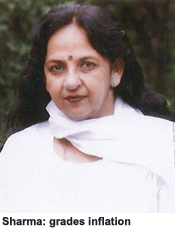 “The reason why college cut-offs are climbing year on year is because an ever larger number of students are averaging above 90 percent in their class XII boards. Until a few years ago, it was a great achievement to pass with distinction, i.e.75 percent, and only a handful of students averaged 90 percent. But today almost everybody gets 90 percent. Grades and marks inflation has devalued our entire evaluation system. Consequently there are thousands of 90 percenters countrywide who have been rejected by colleges of their choice. Immediate steps must be taken by all school exam boards to exercise moderation and tighten their marking systems. Simultaneously there’s an urgent need to overhaul the college admission process to make it more rational and less marks-fixated. More-over a system of creating parity between the various boards must be worked out, based on the percentile rather than percentage system,” says Kavita Sharma, former principal of Hindu College, Delhi and currently director of Delhi’s prestigious India International Centre.
“The reason why college cut-offs are climbing year on year is because an ever larger number of students are averaging above 90 percent in their class XII boards. Until a few years ago, it was a great achievement to pass with distinction, i.e.75 percent, and only a handful of students averaged 90 percent. But today almost everybody gets 90 percent. Grades and marks inflation has devalued our entire evaluation system. Consequently there are thousands of 90 percenters countrywide who have been rejected by colleges of their choice. Immediate steps must be taken by all school exam boards to exercise moderation and tighten their marking systems. Simultaneously there’s an urgent need to overhaul the college admission process to make it more rational and less marks-fixated. More-over a system of creating parity between the various boards must be worked out, based on the percentile rather than percentage system,” says Kavita Sharma, former principal of Hindu College, Delhi and currently director of Delhi’s prestigious India International Centre.
 Dr. Sangeeta Kohli, principal of Somaiya College of Arts, Science and Commerce, Mumbai argues that college managements are forced to raise admission cut-offs to keep pace with the dramatic increase in the number of high performers in board exams. “We’ve increased our junior college (class XI) cut-off to 70 percent this year as the CBSE and state board results are excellent. Some students have scored 99 percent in languages — which used to be near impossible — in CBSE and CISCE board exams. Marks inflation has become common to all examination boards. Even the Maharashtra state board has become very liberal in awarding marks and a large number of students are scoring 90 percent and above. In the circumstances we had no option but to raise our admission cut-offs, forcing students who don’t make the cut to study elsewhere,” says Kohli.
Dr. Sangeeta Kohli, principal of Somaiya College of Arts, Science and Commerce, Mumbai argues that college managements are forced to raise admission cut-offs to keep pace with the dramatic increase in the number of high performers in board exams. “We’ve increased our junior college (class XI) cut-off to 70 percent this year as the CBSE and state board results are excellent. Some students have scored 99 percent in languages — which used to be near impossible — in CBSE and CISCE board exams. Marks inflation has become common to all examination boards. Even the Maharashtra state board has become very liberal in awarding marks and a large number of students are scoring 90 percent and above. In the circumstances we had no option but to raise our admission cut-offs, forcing students who don’t make the cut to study elsewhere,” says Kohli.
It’s not just colleges that are grappling with this curious problem of inflated percentages. Even schools offering higher secondary or Plus Two (class XI-XII) are often obliged to deny their own students admission into class XI. A case in point is the CBSE-affiliated RMK Residential Senior School, Chennai where more than 50 percent of its 40 class X students have been graded A1 (91-100 percent) and A2 (81-90 percent) this year. “With so many top scorers it’s a challenge to allot students their chosen streams in class XI. A majority have applied for admission into the science stream but there isn’t enough capacity. We’ve had to take their class IX grades into consideration and also add one more section for the science stream. Given this situation, there’s no question of admitting students from other schools,” says principal Dr. C. Satish.
Yet at bottom, the root of this depressing annual scramble for admission into the country’s premier Plus Two and undergraduate colleges, is the widening demand-supply imbalance in higher education. A grim reality to which government and academia turn the Nelson’s eye is that the increase in college capacity has been lagging way behind the number of secondary students and higher secondary school-leavers. For instance, while over the past decade the number of Plus Two school-leavers has risen from 1 million to 11 million, the number of colleges and universities has risen from 311 universities and 15,600 colleges in 2000 to 509 and 31,000 in 2010. With financially strapped Central and state governments unable to invest meaningfully in education, and licence-permit-quota raj alive and kicking in higher education, private sector initiatives are few and far between, resulting in a severe demand-supply mismatch. Currently, the higher education system accommodates a mere 12 percent of the 100 million youth in the age group of 18-24 years (cf. 80 percent in the US, 40-50 percent in Europe and 20 percent in China).
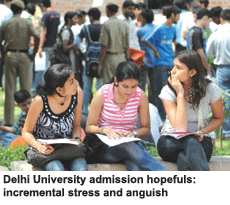 “The rat race for securing high marks in board exams and the mad rush for college admissions will get worse if the government doesn’t urgently address the supply side of higher education. There’s a huge disproportion between availability of college seats and student demand. Since government can’t fund the growth of new higher education institutions, it must not just permit, but actively encourage, private sector initiatives in higher education. All barriers of entry must be removed and government must confer full adminis-trative, financial and academic autonomy on private colleges and universities so they can hire the best faculty and offer world-class education. An open, liberal and transparent policy is urgently required to increase supply and expand capacity in higher educ-ation,” says Rajeev Gowda, an alumnus of the Wharton Business School and professor of economics and social sciences at the Indian Institute of Management, Bangalore.
“The rat race for securing high marks in board exams and the mad rush for college admissions will get worse if the government doesn’t urgently address the supply side of higher education. There’s a huge disproportion between availability of college seats and student demand. Since government can’t fund the growth of new higher education institutions, it must not just permit, but actively encourage, private sector initiatives in higher education. All barriers of entry must be removed and government must confer full adminis-trative, financial and academic autonomy on private colleges and universities so they can hire the best faculty and offer world-class education. An open, liberal and transparent policy is urgently required to increase supply and expand capacity in higher educ-ation,” says Rajeev Gowda, an alumnus of the Wharton Business School and professor of economics and social sciences at the Indian Institute of Management, Bangalore.
Conterminously with deregulation of higher education and a greater role for private sector initiatives, it’s also necessary for the country’s 42 exam boards including CBSE and CISCE to tighten evaluation parameters. The consensus of opinion among educa-tionists is that grades/marks inflation, which forces college managements to raise the bar for admissions, has dangerous social implications.
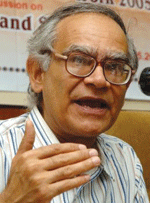 “The evaluation process is faulty and problematic. A position paper on examination reform in the National Curriculum Framework (2005) noted some of these absurdities and recommended measures to stem the tide. But nothing has been done by the boards to rectify the typology and design of question papers in board examinations, with elite schools — which can be leaders in this reform — also perpetuating the status quo. If the evaluation system continues unch-anged, an increasing number of colleges will admit students on arbitrary and chaotic criteria, excluding capable and competent students from the possibility of excelling in higher education. That is a huge loss of human resource in the long run. In schools, the quality of learning will deteriorate as learning will be geared towards scoring perfect marks in board exams to the neglect of problem-solving, creativity and life skills. Coaching shops, of course, will thrive,” warns Prof. Krishna Kumar, hitherto director of National Council for Educational Research and Training (NCERT) and professor of education at Delhi University.
“The evaluation process is faulty and problematic. A position paper on examination reform in the National Curriculum Framework (2005) noted some of these absurdities and recommended measures to stem the tide. But nothing has been done by the boards to rectify the typology and design of question papers in board examinations, with elite schools — which can be leaders in this reform — also perpetuating the status quo. If the evaluation system continues unch-anged, an increasing number of colleges will admit students on arbitrary and chaotic criteria, excluding capable and competent students from the possibility of excelling in higher education. That is a huge loss of human resource in the long run. In schools, the quality of learning will deteriorate as learning will be geared towards scoring perfect marks in board exams to the neglect of problem-solving, creativity and life skills. Coaching shops, of course, will thrive,” warns Prof. Krishna Kumar, hitherto director of National Council for Educational Research and Training (NCERT) and professor of education at Delhi University.
Incremental rather than diminishing student stress and anguish, which was quite evident in the recently concluded college admissions season, has deflated the widespread euphoria generated by the unprecedented high percentages obtained by schools — especially CBSE-affiliated schools — across the country. Suddenly it’s plainly manifest to the parent, teacher and student communities that in an era of grades/marks inflation, encomiums won by schools on the swings by way of huge numbers of students passing with distinction, is lost on the admissions roundabout with college managements entertaining only 90 percenters and above.
Now it’s time for the country’s glib HRD minister Kapil Sibal and his acolytes in the ministry to acknowledge that quick-fix solutions such as CCE, optionalisation of the class X boards and the half-baked RTE Act, 2009 among other in-limbo ministry initiatives are no substitute for substantially higher budgetary allocations for education and root and branch reforms to expand capacity and raise teaching-learning and research standards in higher education.
Quite clearly — as testified by the vast student and institutional stress witnessed in the college admission season this year — quick-fix legislation and reckless experimentation will exacerbate, rather than abate, strain and anxiety in Indian education.
With Autar Nehru & Payal Mahajan (Delhi); Manas Shrivastava (Mumbai) & Hemalatha Raghupathi (Chennai)